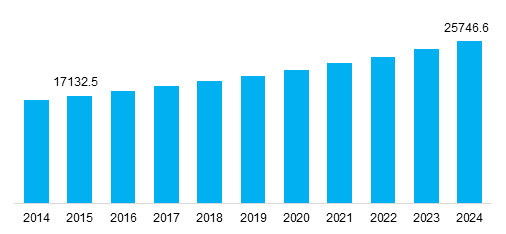Legalizing Cannabis to Impact Opioids Agonist Drugs Market Growth
Opioids are generally prescribed for treating pain. The opioid drug class includes morphine, hydrocodone, oxycodone, heroin, codeine, morphine, fentanyl, and methadone. It is also used as a cough suppressant and in diarrhea treatment. Opioids can be administered either through pills, liquids, intravenous, transdermal patches, or lozenges. Developed countries in North America and Europe are notorious for the high levels of abuse of this drug. Drugs such as codeine, morphine, fentanyl, and hydrocodone have become a source of addiction, especially among the population in these regions due to easy availability of the drugs in these regions. According to the World Drug Report 2016, a staggering 17.4 million people were affected by opioid drug abuse in 2014. However, global organizations and regulatory agencies such as the FDA, Centers for Disease Control and Prevention (CDC) and World Health Organization (WHO) are working towards limiting the abuse of opioids by creating awareness and educating prescribers to be cautious while prescribing these drugs. In 2016, the CDC issued guidelines to prescribe opioids, limiting the daily dose of opioids to 90 morphine milligram equivalent (MME).
In recent times, cannabis has emerged as a potential alternative for opioids. Cannabis is legalized in many states in the U.S. as it is considered safer than opioids. U.S. being a major consumer of such drugs, legalizing cannabis (marijuana) is expected to have a detrimental impact on the opioids market growth.
The global opioids market was valued at US$ 17,132.5 million in 2015 and is expected to witness a moderate CAGR of 4.2% during the forecast period (2016 – 2024).
Figure 1. Global Opioids Agonist Drugs Market Size and Forecast, US$ Million, 2014–2024

To learn more about this report, Request sample copy
Source: Coherent Market Insights Analysis (2017)
To have a snippet of the report, request Report Sample
Increasing prevalence of chronic pain is expected to drive the opioids market growth
According to the American Academy of Pain Medicine (2011), the number of people who suffered from chronic pain was around 1.8 billion. Moreover, according to the NIH estimates (2015), one in 10 people in the U.S. suffer from chronic pain. Around one-third to half of the population in the U.K. suffers from chronic pain, according to a study published in the British Medical Journal in 2016. Opioids are commonly used for treating pain, and opioid containing drugs are being misused or are being consumed in overdose when patients follow self-medication. Moreover, rising prevalence of pain, cough and, diarrhea are other factors driving growth of the opioids agonist drugs market. The highly prescribed opioid in the U.S. is hydrocodone.
Opioids market majorly impacted by rising adoption of cannabis
The global opioids market experiences volatility due to various factors such as rampant production of opium and inclination of the masses towards use of alternate drugs such as cannabis. Cannabis is now being legalized in most parts of the U.S.—the major consumer of cannabis drug. Moreover, cannabis is the most cultivated drug crop in the world. Also, consumers in the U.S. find administering cannabis more effective than opioids, which is also impacting consumption of opioids. Due to this, Colorado is experiencing a decline in the number of opioid deaths. Cannabis is considered to be a healthy alternative to opioids. U.S. accounted for 77% share in the global opioids market in 2015. A study conducted by researchers at the University of British Columbia, found that 32% of Canadians switched from using opioids to cannabis for relieving pain. Production of opium according to the World Drug Report 2016 declined in 2015 by 38% compared to that in 2014.
Increasing drug abuse impacting the opioids agonist drugs market outlook
The U.S. FDA considers all opioids as schedule 2 drugs—drugs that have high abuse potential. Codeine, fentanyl, meperidine, methadone, morphine, and hydrocodone are the most abused prescription opioid analgesics. Contrary to other regions, wherein codeine is expected to dominate the market globally, North America is expected to be primarily driven by sales of hydrocodone opioids. Drug abuse with opioid is characterized by prolonged use or overdosing of the prescribed medication. A 2015 study by the CDC concluded that people who are addicted to prescription analgesics are 40 times more likely to be addicted to heroin. Furthermore, CDC also states that 73% of all drug overdose deaths in the U.S. in 2015 were due to opioids (57% in 2010). Although the use of prescription opioid for non-medical purpose has decreased over 2012–2014, use of heroin has increased significantly during this period. The deaths accounted due to opioid abuse has also increased consequently over the years. According to the National Institutes of Health (NIH) 2015 data, there was a 2.8 fold increase in deaths in the U.S. due to overdose of opioid during 2002–2014. The death incidence rose to nearly 33,000 in 2015 from 23,000 in 2012 in the U.S. Similarly, non-prescription use of cough syrups containing codeine is also a major issue to be addressed.
Share
Share
Missing comfort of reading report in your local language? Find your preferred language :
Transform your Strategy with Exclusive Trending Reports :
Frequently Asked Questions
Select a License Type
Credibility and Certifications

860519526

9001:2015
27001:2022


Joining thousands of companies around the world committed to making the Excellent Business Solutions.
View All Our Clients
US Reciprocal Tax Impact Analysis On Opioids Agonist Drugs Market
Stay updated on tariff changes with expert insights and timely information